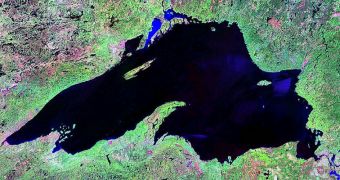Scientists at the Cornell University College of Veterinary Medicine have been recently able to determine that Lake Superior is contaminated with a very dangerous viral agent, called the viral hemorrhagic septicemia virus, or VHSV. While relatively safe for humans – despite being from the same class of pathogens as rabies – the microorganism can easily wreck havoc among fish populations, and cause widespread damage to fish groups in aquaculture setups as well. The new finding was confirmed by scientists at the US Geological Survey (USGS) Western Fisheries Research Center, in Seattle.
“VHS is one of the most important diseases of finfish. It not only affects the health and well-being of populations of several important native fish species, but it can also impact trade, and, should it spread into the US aquaculture industry, could do substantial damage as happened in Europe and parts of Japan,” WFRC VHSV expert James Winton explains. He worked together with colleague Dr. Gael Kurath on confirming the original findings of the Cornell team.
This viral agent is extremely dangerous, authorities warn, as it has the ability to produce a massive population loss in a great deal of species. As such, it produces one of the few diseases that fishermen must necessarily report to the United Nations (UN) World Organization for Animal Health. Experts are however relatively happy that it took this long for the virus to make its way in the waters of Lake Superior. It was discovered in the other Great Lakes in 2005, after massive fish stock die-offs alerted health officials that something was amiss in the waters. An infection of Lake Ontario took less than four days to kill off 40,000 freshwater drums.
“Experts fear the disease could potentially spread from the Great Lakes into new populations of native fish in the 31 states of the Mississippi River basin. Federal and State agencies had previously placed restrictions on movement of fish or fish products to slow the spread of the virus; however, the presence of a reportable pathogen in the Great Lakes States, large mortalities among wild species, potential impacts on commercial aquaculture and disruption of interstate and international trade have caused substantial concern among management agencies,” experts at the USGS say.

 14 DAY TRIAL //
14 DAY TRIAL //